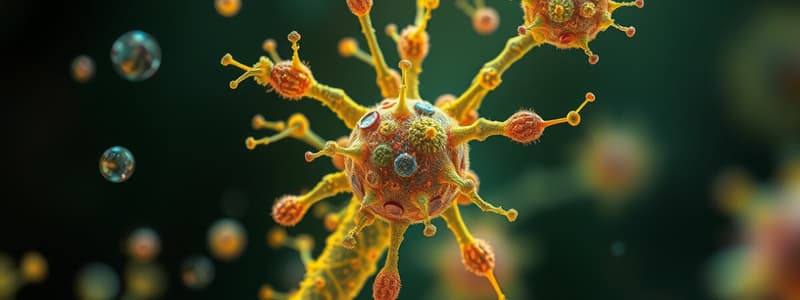Podcast
Questions and Answers
Which best describes the focus of microbiology?
Which best describes the focus of microbiology?
- Understanding microbial cells and their influence on the environment and human life. (correct)
- An exploration of the microbial processes exclusively in human health.
- A specialized area of biology dealing with organisms that can be seen without magnification.
- The study of macroscopic organisms and their interactions with each other.
What is a hallmark of the diversity of microbes?
What is a hallmark of the diversity of microbes?
- Microbes are all unicellular and cannot form clusters.
- All microbes are capable of aerobic respiration only.
- Microbes exhibit a limited range of metabolic processes.
- Microbes can survive in various environments through genetic diversity. (correct)
Which group is NOT classified as a microbe?
Which group is NOT classified as a microbe?
- Bacteria
- Protozoa
- Viruses
- Plants (correct)
How do anaerobic microbes function in their environments?
How do anaerobic microbes function in their environments?
Which unifying theme in microbiology emphasizes the connection between microbes and visible life?
Which unifying theme in microbiology emphasizes the connection between microbes and visible life?
Which classification scheme introduced the concept of the kingdom Protista?
Which classification scheme introduced the concept of the kingdom Protista?
What are the two major categories in Edouard Chatton's 2 Empire System?
What are the two major categories in Edouard Chatton's 2 Empire System?
Which criterion used by Whittaker distinguishes between absorptive heterotrophy and ingestive heterotrophy?
Which criterion used by Whittaker distinguishes between absorptive heterotrophy and ingestive heterotrophy?
In the 6-Kingdom classification, which kingdom includes organisms with cell walls lacking peptidoglycan?
In the 6-Kingdom classification, which kingdom includes organisms with cell walls lacking peptidoglycan?
Which of the following nutritional modes is also referred to as saprobic nutrition?
Which of the following nutritional modes is also referred to as saprobic nutrition?
Flashcards are hidden until you start studying
Study Notes
Microbiology Overview
- Microbiology combines the Greek words "logos" (science), "micro" (small), and "bios" (life).
- It focuses on organisms that are too small to be seen without magnification and encompasses various forms of life, primarily single-celled organisms.
Key Themes in Microbiology
- Understanding microscopic life and its processes.
- Harnessing microbial knowledge for human and environmental benefit.
- Investigating microbial diversity, evolution, and their roles in ecosystems.
Microorganisms Defined
- Microbes are predominantly single-celled but can also be multicellular, albeit less complex than plants and animals.
- Oldest life forms on Earth; essential for processes like nutrient cycling and respiration.
Major Groups of Microbes
- Bacteria, Archaea, Fungi, Algae, Protozoa, Viruses, Prions, and Viroids.
Unifying Themes
- Microbes are foundational to visible life; they influence ecosystems and human health.
- Show remarkable genetic and metabolic diversity.
- Some microbes thrive in anaerobic conditions, exploiting these niches.
- Survive in a wide range of environments, illustrating their adaptability.
- Possess the greatest genetic and evolutionary diversity among life forms.
Historical Classification Schemes
- Carolus Linnaeus (1735): Established a 2-kingdom system (Animalia for protozoa and animals, Vegetabiliae for bacteria and plants).
- Ernst Haeckel (1866): Proposed a 3-kingdom scheme adding Protista for simpler organisms.
- Edouard Chatton (1937): Introduced a 2-empire system distinguishing Prokaryotic (no nucleus) and Eukaryotic (with nucleus) organisms.
- Herbert Copeland (1956): Developed a 4-kingdom scheme that included a distinct kingdom for unicellular prokaryotes, Monera.
- Robert Harding Whittaker (1969): Introduced a 5-kingdom system reflecting complexity in nutrition and cell structure.
- Carl Woese (1977): Proposed a 6-kingdom system based on cellular organization, distinguishing Eubacteria and Archaebacteria.
Whittaker's Criteria for Classification
- Complexity of cell structure (prokaryotic vs. eukaryotic).
- Complexity of body structure (unicellular vs. multicellular).
- Method of nutrition variations specific to kingdoms:
- Photoautotrophy in Plantae
- Absorptive heterotrophy in Fungi
- Ingestive heterotrophy in Animalia
- Ecological roles such as producers (Plantae), decomposers (Fungi), consumers (Animalia).
- Phylogenetic relationships among organisms.
Woese's Domains of Life
- Organized all life into three domains:
- Bacteria: Characterized by cell walls with peptidoglycan.
- Archaea: Distinct from bacteria, lacking peptidoglycan in cell walls.
- Eukarya: Divided into subgroups including Protists, Fungi, Plants, and Animals, each with unique characteristics.
Studying That Suits You
Use AI to generate personalized quizzes and flashcards to suit your learning preferences.




